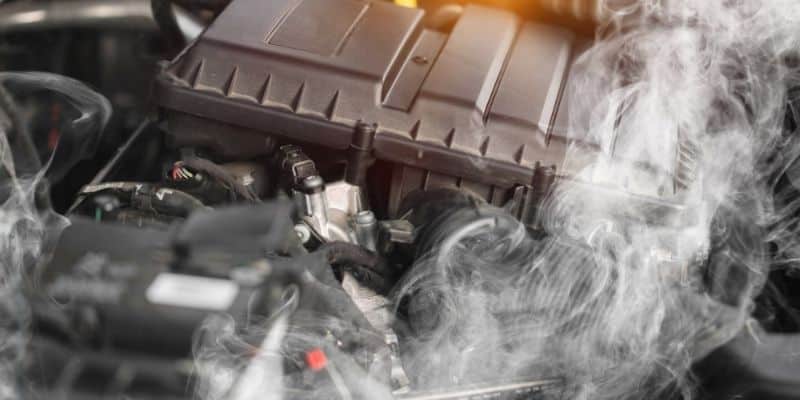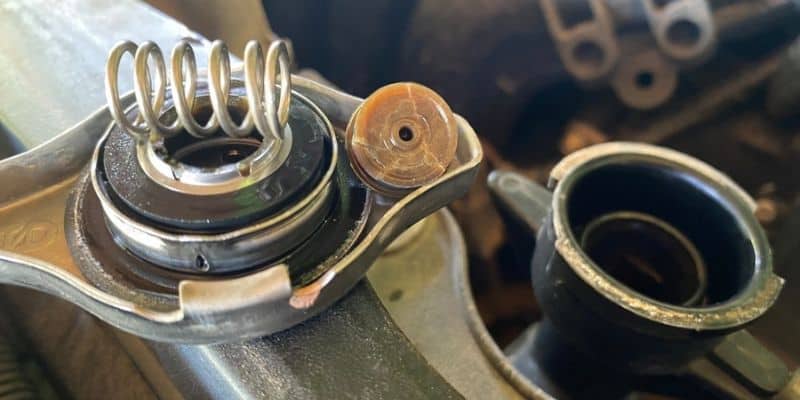The coolant reservoir cap is a crucial component of a vehicle’s cooling system, responsible for maintaining the necessary pressure within the coolant system.
Over time, the cap can deteriorate and develop issues, potentially leading to coolant leaks and engine overheating.
In this comprehensive guide, we will explore the signs of bad coolant reservoir cap, their fixing, and the consequences of driving your car with a bad reservoir cap.
Understanding the Coolant Reservoir Cap
The coolant reservoir cap is typically located on the coolant reservoir tank, which serves as a storage and expansion area for the coolant. This cap plays a vital role in maintaining the pressure within the cooling system, ensuring efficient cooling and preventing coolant loss.
Signs of Bad Coolant Reservoir Cap
1. Coolant Leakage
One of the primary signs of a failing coolant reservoir cap is coolant leakage. You may notice puddles of coolant beneath the vehicle or signs of seepage around the cap or reservoir. Leakage occurs when the cap fails to seal properly, allowing coolant to escape.
2. Overheating Engine
A malfunctioning coolant reservoir cap can disrupt the pressure balance within the cooling system. As a result, the engine may experience overheating.
If you observe the temperature gauge rising beyond the normal range or the engine overheating warning light illuminating, it is a clear indication of a potential problem with the cap.
3. Low Coolant Levels
A defective coolant reservoir cap can cause coolant to escape from the reservoir, leading to a gradual decrease in coolant levels.
Regularly monitor the coolant level in the reservoir and pay attention to any significant or recurring drops. Low coolant levels can result in engine overheating and should not be ignored.
4. Steam or Vapor from the Engine Bay
When a coolant reservoir cap fails to maintain proper pressure, excess pressure can escape from the cooling system.
This can manifest as steam or vapor being released from the engine bay. You may also notice a distinct hissing sound accompanying the release of pressure.
5. Milky or Discolored Coolant
A compromised coolant reservoir cap can allow contaminants, such as oil or dirt, to enter the cooling system.
This can cause the coolant to appear milky or discolored. If you notice a change in the color or consistency of the coolant, it may indicate a problem with the cap.

Fixes for a Bad Coolant Reservoir Cap
1. Inspect and Clean the Cap
Begin by inspecting the coolant reservoir cap for any visible signs of damage, such as cracks, worn-out seals, or deformation.
Clean the cap thoroughly, ensuring it is free from debris or coolant residue. If the cap appears worn or damaged, it is advisable to replace it.
2. Replace the Coolant Reservoir Cap
If the inspection reveals significant signs of wear or the cap fails to seal properly, it is recommended to replace it with a new one.
Ensure that the replacement cap meets the specifications recommended by the vehicle manufacturer to ensure proper fit and functionality.
3. Check and Flush the Cooling System
To ensure the overall health of the cooling system, consider performing a thorough coolant system flush. Flushing the cooling system helps remove any contaminants, debris, or old coolant that may have entered due to a faulty cap.
It is a good practice to flush the system periodically, even if there are no immediate issues with the cap.
4. Seek Professional Assistance
If you are unsure about inspecting or replacing the coolant reservoir cap yourself, it is advisable to seek professional assistance.
An experienced mechanic can diagnose the problem accurately and provide appropriate solutions to resolve any issues with the cap or the cooling system.
Risks of driving with a bad reservoir cap
Driving with a bad coolant reservoir cap can have several potential consequences, some of which can be quite serious.
Here are the potential risks and consequences of driving with a faulty coolant reservoir cap:
Coolant Loss
A bad coolant reservoir cap may not seal the reservoir properly, leading to coolant leakage. If coolant levels drop significantly, it can result in insufficient coolant circulating through the engine. This can cause the engine to overheat, leading to potential engine damage.
Engine Overheating
When the coolant reservoir cap fails to maintain the necessary pressure in the cooling system, it can disrupt the proper flow of coolant.
Without adequate coolant circulation, the engine can overheat rapidly, especially during extended periods of driving or under heavy loads.
Engine overheating can cause severe damage to vital engine components like cylinder heads, gaskets, and pistons.
Increased Risk of Engine Failure
Continuous driving with a bad coolant reservoir cap can increase the risk of engine failure. The excessive heat generated by the overheating engine can cause critical engine components to warp, crack, or seize.
Engine repairs or replacement can be costly and time-consuming.
Warped Cylinder Head
Overheating resulting from a faulty coolant reservoir cap can cause the cylinder head to warp. A warped cylinder head can lead to compression loss, coolant leakage into the combustion chamber, or engine misfires.
Repairing or replacing a warped cylinder head is an expensive repair job.
Blown Head Gasket
A blown head gasket is another potential consequence of driving with a bad coolant reservoir cap. When the engine overheats, extreme temperatures, and pressure can cause the head gasket to fail.
A blown head gasket can result in coolant mixing with engine oil, exhaust gases entering the coolant system, and engine performance issues. Repairing a blown head gasket is a complex and costly repair.
Seized Engine
In extreme cases, prolonged driving with a malfunctioning coolant reservoir cap can lead to engine seizure.
Engine seizure occurs when the excessive heat causes the internal moving parts to expand and seize up, rendering the engine inoperable. A seized engine typically requires a complete engine replacement.
What causes the reservoir cap to go bad?
Several factors can contribute to the deterioration or failure of a coolant reservoir cap. Here are some common causes:
Age and Wear: Over time, the materials used in the construction of the coolant reservoir cap can degrade due to exposure to heat, pressure, and coolant chemicals.
The constant cycles of heating and cooling can cause the cap’s seals and gaskets to become brittle, resulting in leaks or loss of pressure.
Seal Deterioration: The coolant reservoir cap relies on seals and gaskets to create a tight seal and maintain the pressure within the cooling system.
Continuous exposure to high temperatures, coolant chemicals, and aging can cause these seals to degrade or harden, leading to a compromised seal and eventual failure of the cap.
Incorrect Installation: Improper installation of the coolant reservoir cap can contribute to its premature failure. If the cap is not tightened securely or aligned correctly on the reservoir, it can lead to leaks or ineffective pressure regulation.
Contaminants and Debris: Contaminants such as dirt, debris, or coolant additives can accumulate around the cap’s sealing surfaces over time.
These contaminants can interfere with the cap’s ability to form a proper seal, resulting in leaks or loss of pressure.

Excessive Pressure or Pressure Cycling: The cooling system operates under specific pressure parameters.
If the pressure within the system exceeds the cap’s specified limits or experiences rapid pressure cycling, it can strain the cap and cause it to degrade or fail prematurely.
Chemical Damage: Coolant additives and chemicals can affect the materials used in the construction of the coolant reservoir cap.
Some additives or coolant mixtures can accelerate the deterioration of the cap’s seals or weaken the cap’s structural integrity, leading to failure.
Physical Damage: Accidental damage, such as impacts or cracks on the cap due to mishandling or accidents, can compromise its functionality and cause leaks or pressure loss.
Cost to repair or replace the reservoir cap
The cost of replacing or repairing a bad coolant reservoir cap can vary depending on several factors such as the make and model of the vehicle.
- The price of the reservoir cap itself is relatively inexpensive, typically ranging from $10 to $50.
- If you opt for a DIY approach and replace the coolant reservoir cap yourself, you can save on labor costs. However, it’s crucial to ensure that you select the correct cap that matches the manufacturer’s specifications to ensure a proper fit and functionality.
- Professional assistance may incur additional costs, including labor charges in addition to the price of the cap.
- The cost of professional repair or replacement can range from $50 to $200, encompassing parts and labor. However, these figures are approximate and can vary depending on various factors.
Can a bad radiator cap cause coolant loss?
Yes, a bad radiator cap can cause coolant loss. The radiator cap serves as a crucial component in maintaining the pressure and integrity of the cooling system. If the radiator cap is faulty, it may not seal properly, leading to coolant leakage.
Here’s how a bad radiator cap can contribute to coolant loss:
- Ineffective Seal: A faulty radiator cap may fail to create a tight seal, allowing coolant to escape from the system.
- Pressure Release Issues: A malfunctioning cap’s pressure relief valve can cause an over-pressurized system, leading to coolant loss.
- Boiling Over: A bad radiator cap can result in lower boiling points for the coolant, causing it to boil over and escape.
- Air Intrusion: If the radiator cap allows air to enter the system, it can disrupt coolant circulation and lead to coolant loss.
Can a bad radiator cap cause a check engine light?
No, a bad radiator cap is unlikely to cause the check engine light to illuminate. The check engine light typically indicates a problem with the vehicle’s engine or emissions system, and a faulty radiator cap does not directly relate to these areas.
However, it’s important to note that some modern vehicles may have a coolant level sensor integrated into the coolant reservoir cap. If this sensor detects low coolant levels due to a faulty cap, it may trigger the check engine light indirectly.
Can a bad radiator cap cause white smoke?
No, a bad radiator cap is not a direct cause of white smoke. White smoke typically indicates a coolant-related issue or a problem with the engine’s combustion process. While a faulty radiator cap can lead to coolant loss, it does not directly generate white smoke.
Can a bad radiator cap cause bubbling?
Yes, a bad radiator cap can potentially cause bubbling in the coolant system. The radiator cap plays a crucial role in maintaining the proper pressure within the cooling system. If the cap is faulty or not sealing correctly, it can disrupt the balance of pressure and lead to bubbling or foaming of the coolant.
When the cooling system is operating normally, the radiator cap seals the system, allowing pressure to build up as the coolant heats up. This increased pressure raises the boiling point of the coolant, preventing it from boiling and causing excessive bubbling.
FAQs (Frequently Asked Questions)
Can a bad coolant reservoir cap cause engine damage?
Yes, a failing coolant reservoir cap can potentially lead to engine damage if left unaddressed. Engine overheating resulting from a faulty cap can cause severe consequences such as warped cylinder heads, blown gaskets, or even a seized engine.
How often should I replace the coolant reservoir cap?
There is no specific replacement interval for the coolant reservoir cap. It is advisable to inspect the cap during routine maintenance or whenever you notice any signs of wear or malfunction.
If in doubt, consult your vehicle’s manufacturer guidelines or seek advice from a qualified mechanic.
Can I drive with a bad coolant reservoir cap?
Driving with a bad coolant reservoir cap is not recommended. It can lead to coolant loss, engine overheating, and potential engine damage.
It is best to address the issue promptly and replace the cap to avoid further complications.
Conclusion
The coolant reservoir cap is a small yet critical component of the vehicle’s cooling system.
Understanding the signs of a bad coolant reservoir cap, such as coolant leakage, engine overheating, low coolant levels, vapor or steam from the engine bay, and discolored coolant, is essential for timely intervention.
By inspecting, cleaning, and replacing the coolant reservoir cap when necessary, you can prevent coolant leaks, engine overheating, and potential engine damage.

Hi, Michael Williams here. I have always loved everything with an engine. After earning my degree in automotive engineering, I spent 5 years testing vehicles for a major manufacturer in Illinois. Now I am using my technical skills to review the latest models online and help others troubleshoot their engine problems with effective solutions.
